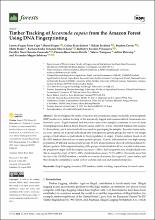Por favor, use este identificador para citar o enlazar este ítem:
https://hdl.handle.net/20.500.12921/758| Título : | Timber Tracking of Jacaranda copaia from the Amazon Forest Using DNA Fingerprinting |
| Autor : | Frigini Moro, Lorena Capo Degen, Bernd Blanc-Jolivet, Celine Tysklind, Niklas Cavers, Stephen Malte, Mader Venancio Meyer-Sand, Barbara Paredes-Villanueva, Kathelyn Honorio Coronado, Eurídice García-Dávila, Carmen Rosa Troispoux, Valerie Delcamp, Adline Sebbenn, Alexandre Magno |
| Palabras clave : | Jacaranda Amazon Forest |
| Fecha de publicación : | 16-ago-2024 |
| Editorial : | Estados Unidos |
| Citación : | Sebbenn, A., Capo, L., Degen, B., Blanc-Jolivet, C., Mader, M., Cavers, S., ... & Delcamp, A. (2024). Timber tracking of Jacaranda copaia from Amazon Forest using DNA fingerprint. |
| Resumen : | We investigated the utility of nuclear and cytoplasmic single nucleotide polymorphism (SNP) markers for timber tracking of the intensively logged and commercialized Amazonian tree Jacaranda copaia. Eight hundred and thirty-two trees were sampled (cambium or leaves) from 38 sampling sites in Bolivia, Brazil, French Guiana, and Peru. A total of 128 SNP markers (113 nuclear, 11 chloroplastic, and 4 mitochondrial) were used for genotyping the samples. Bayesian cluster analyses were carried out to group individuals into homogeneous genetic groups for tests to self-assign groups of individuals or individuals to their population of origin. Cluster analysis based on all the SNP markers detected seven main genetic groups. Genetic differentiation was high among populations (0.484) and among genetic groups (0.415), and populations showed a strong isolation-by-distance pattern. Self-assignment testing of the groups of individuals for all loci was able to determine the population origin of all the samples (accuracy = 100%). Self-assignment tests of individuals were able to assign the origin of 94.5%–100% of individuals (accuracy: 91.7%–100%). Our results show that the use of the 128 SNP markers is suitable to correctly determine the origin of J. copaia timber, and they should be considered a useful tool for customs and local and international police. |
| URI : | https://hdl.handle.net/20.500.12921/758 |
| ISSN : | 1999-4907 |
| Aparece en las colecciones: | Artículos en revistas indexadas |
Ficheros en este ítem:
| Fichero | Descripción | Tamaño | Formato | |
|---|---|---|---|---|
| forests-15-01478-v2.pdf | 3,39 MB | Adobe PDF |  Visualizar/Abrir |
Compartir :
Los ítems de DSpace están protegidos por copyright, con todos los derechos reservados, a menos que se indique lo contrario.



